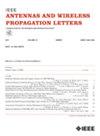一种新型交叉环滤波器结构的双极化滤波偶极子天线
IF 4.8
2区 计算机科学
Q2 ENGINEERING, ELECTRICAL & ELECTRONIC
引用次数: 0
摘要
本文提出了一种新的双极化滤波天线设计方法,即在传统的平衡馈电偶极子天线结构中插入一种新的交叉环滤波器。首先分析了交叉环滤波器结构的性能,揭示了不同的端口选择产生不同的阻带效果。具体来说,激励交叉结构的水平端口会在高频率处引入阻带,而选择垂直端口会在低频率处产生阻带。利用这一现象,两个三阶交叉环结构在辐射臂下垂直定位,实现双极化操作。这种结构的集成使天线能够达到期望的带通辐射响应。为了验证,制作并测试了所提出的天线。结果表明,该天线的阻抗带宽为1.88 GHz ~ 2.41 GHz,有两个可控的辐射零点,带外辐射抑制水平超过19 dB。这些优点使其成为基站天线系统的优秀候选者。本文章由计算机程序翻译,如有差异,请以英文原文为准。
Dual-Polarized Filtering Dipole Antenna Using a Novel Crossover Ring Filter Structure
This letter presents a different dual-polarized filtering antenna design method by inserting a novel crossover ring filter into a conventional balun-feed dipole antenna structure. The performance of the crossover ring filter structure is first analyzed, revealing that different port selections yield distinct stopband effects. Specifically, exciting the horizontal ports of the crossover structure introduces a stopband at upper frequencies while selecting vertical ports generates a stopband at lower frequencies. Leveraging this phenomenon, two third-order crossover ring structures are orthogonally positioned beneath the radiating arms for dual-polarization operation realization. The integration of this structure enables the antenna to achieve the desired bandpass radiation response. For verification, the proposed antenna was fabricated and tested. The results indicate that the antenna achieves an impedance bandwidth of 1.88 GHz to 2.41 GHz, two controllable radiation nulls, and an out-of-band radiation suppression level exceeding 19 dB. These advantages make it an excellent candidate for base station antenna systems.
求助全文
通过发布文献求助,成功后即可免费获取论文全文。
去求助
来源期刊
CiteScore
8.00
自引率
9.50%
发文量
529
审稿时长
1.0 months
期刊介绍:
IEEE Antennas and Wireless Propagation Letters (AWP Letters) is devoted to the rapid electronic publication of short manuscripts in the technical areas of Antennas and Wireless Propagation. These are areas of competence for the IEEE Antennas and Propagation Society (AP-S). AWPL aims to be one of the "fastest" journals among IEEE publications. This means that for papers that are eventually accepted, it is intended that an author may expect his or her paper to appear in IEEE Xplore, on average, around two months after submission.

 求助内容:
求助内容: 应助结果提醒方式:
应助结果提醒方式:


